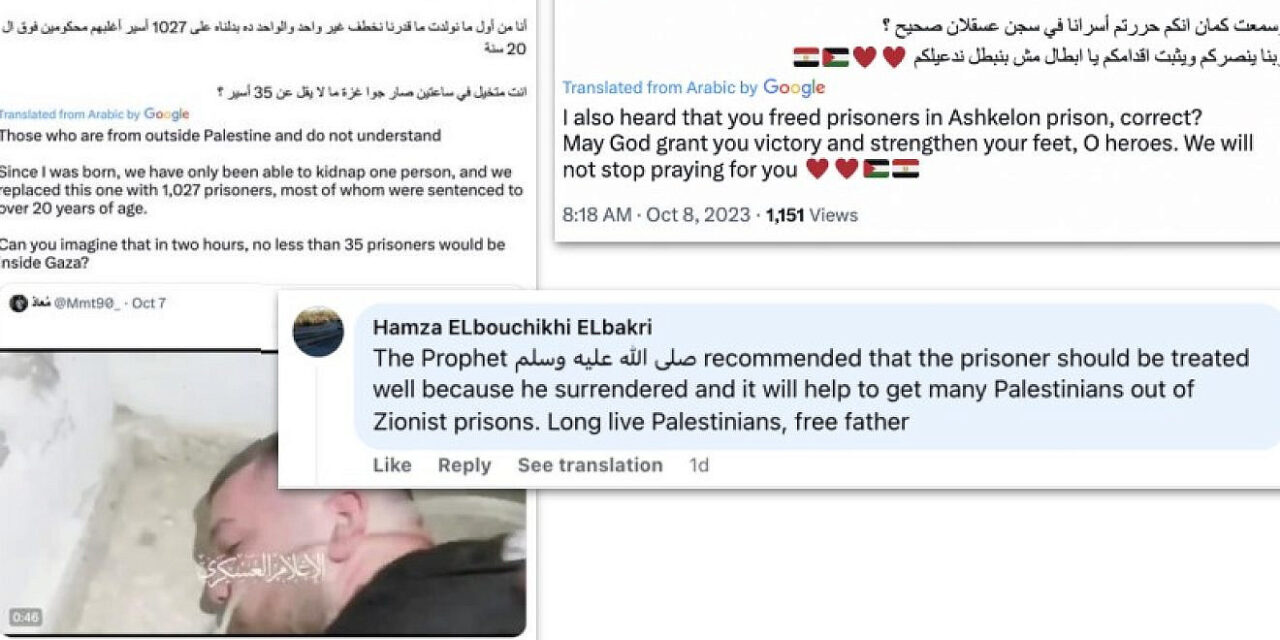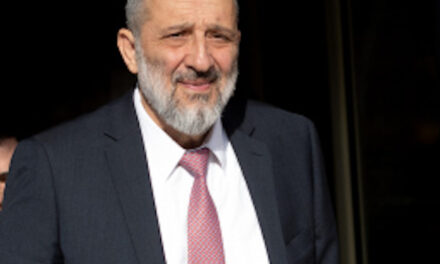Posts claiming Palestinian terrorists held in Israeli prison will be freed, Oct. 16 2023. Screenshot by Cyabra.
(JNS)
As the Israeli Air Force continues to attack Hamas and Islamic Jihad targets in Gaza and Israel Defense Forces ground units enter the Strip, Israeli intelligence and cybersecurity companies are joining the online struggle away from the physical battlefield.
Hamas leverages social media campaigns to gain international support and to wage psychological warfare against Israelis, posting graphic content showing war crimes terrorists committed against civilians.
Israeli cybersecurity companies are fighting to squelch disinformation campaigns coming from Gaza.
Rafi Mendelsohn, vice president for marketing at Cyabra, which specializes in uncovering fake accounts, online threats and disinformation campaigns, discussed with JNS what information is coming out of Gaza and how the social threat intelligence firm is helping the State of Israel.
“Think of Cyabra as a social media search engine. Anyone can monitor conversations on all the main social media platforms and identify online fake profiles by searching a topic in English, Hebrew, Arabic or any other language,” he said on Tuesday.
Three Narratives
With regards to Hamas, Cyabra identified 40,000 fake profiles in searches conducted on Oct. 7 and 8, the weekend of the Islamist organization’s assault on the western Negev that killed more than 1,400 persons and wounded more than 4,500 others, Mendelsohn said.
Hamas’s disinformation campaign breaks down into three narratives, he said.
▪ “The first one is directed at a universal audience and revolves around the compassion and humanity that Hamas supposedly shows to Israeli hostages. Hamas uses real footage, edits it and distributes it en masse via fake profiles. It is important to reiterate that the footage is real but taken completely out of context.”
On Oct. 16, Hamas spokesman Abu Obaida released a statement referring to foreign captives as “guests,” vowing to protect them and to release them whenever conditions on the ground allow. A video showing a French-Israeli dual citizen being treated for an arm injury and saying she had received fair treatment is part of this effort.
▪ The second narrative is aimed at a Palestinian audience and tends to justify the abduction of Israeli civilians with the promise to get thousands of Palestinian terrorists, in Israeli custody, freed, referring to past prisoner swaps.
▪ The third narrative, disseminated in both Arabic and English, speaks of the perceived transgressions and desecration of the al-Aqsa mosque on the Temple Mount in Jerusalem by the State of Israel, which is used to justify Hamas’s terrorist acts.
Fact-checking
Mendelsohn said the level of organization, planning and sophistication with which Hamas spreads disinformation online shows that beyond its ground invasion, the terrorist organization has been preparing its online offensive for months.
When asked how to cope with fake news in times of war and while searching for the latest developments on social media, he stressed the importance of fact-checking.
“You should always question the source, especially when it comes to emotional videos and images. We see many fake profiles that were created a year and a half ago and became especially active on Oct. 7 and Oct. 8. Taking a quick look at a profile and seeing that it is posting every couple of minutes could be an indication that it is not authentic. People should be analyzing what they see before making the important decision of sharing it with others,” Mendelsohn said.
Existing Vulnerabilities
David Allouch, the CEO of ClickFreeze, an Israeli AI firm that focuses on predictive investigation to identify and thwart internet bots, notes a substantial increase in attempts to hack Israeli websites through the exploitation of existing vulnerabilities.
“We’ve learned our lessons from the 2006 [Second] Lebanon War: In one day, 2,000 websites were hacked and inaccessible to internet users. Our online infrastructure both public and private is now reinforced on a national scale,” he told JNS.
Some Israeli tech defenders are taking matters into their own hands, Allouch said. He cited a group on Telegram where organizers assign missions to participants to hack disinformation websites. Targets include websites questioning whether the terrorists killed babies and describing victims of Hamas’s murderous assault as paid actors. Once the participant notifies the organizer that he is aware of the mission, the message disappears.
The @WeRedEvils Telegram hacker group claimed at 6 p.m. Israel time on Oct. 18 that its team managed to break into the Iranian electricity network and disable entire systems in Tehran. This has not yet been confirmed.
Ram Levi, founder and CEO of the Konfidas cybersecurity consulting firm, created, in partnership with Google and the Israel Internet Association, a WhatsApp bot that allows anybody to scan a URL in order to verify its authenticity.
There had been a rise in ransomware and denial of service attacks since the war began, Levi told JNS on Tuesday, Oct 17. He hasn now developed, a security checklist for healthcare institutions and infrastructure; a 24/7 cyber incident response room; and a free endpoint detection and response (EDR) system that reinforces the security posture of Israeli businesses against cyber threats.
Levi recounts how he made the decision to put his expertise at the service of the state, beyond protecting Israelis in the online sphere. “When we learned that Hamas had kidnapped hostages, we contacted the families, asked for technical details such as information relating to the iCloud account of their loved ones, and tried to locate them through their devices. We even worked with cellular companies to get coordinates of their phones and confirm the hostages were in fact in Gaza.”
Shay Har-Noy, CEO at Edgybees, a company that improves the accuracy of aerial video and satellite imagery through machine learning and artificial intelligence (ML/AI), described to JNS on Tuesday how the software he developed provides the IDF with visual context in real-time, highlighting roads, buildings and other important location data on top of satellite and motion imagery.
“Every satellite photo that’s captured from above involves a margin of error, and in densely populated areas, if your footage is off by 20 meters, you could be targeting the wrong building. Our software dramatically increases the accuracy of gathered data. When collecting intelligence, you can use our software to cross-reference your data with maps, addresses and elements gathered from other sensors.”
Since the war began, Har-Noy’s team has increased the urgency and the closeness of coordination with which they assist Israeli tactical and operational units with immediate needs, he told JNS.
“Accuracy saves civilian lives on both sides. What we do is critical in densely populated areas.”








